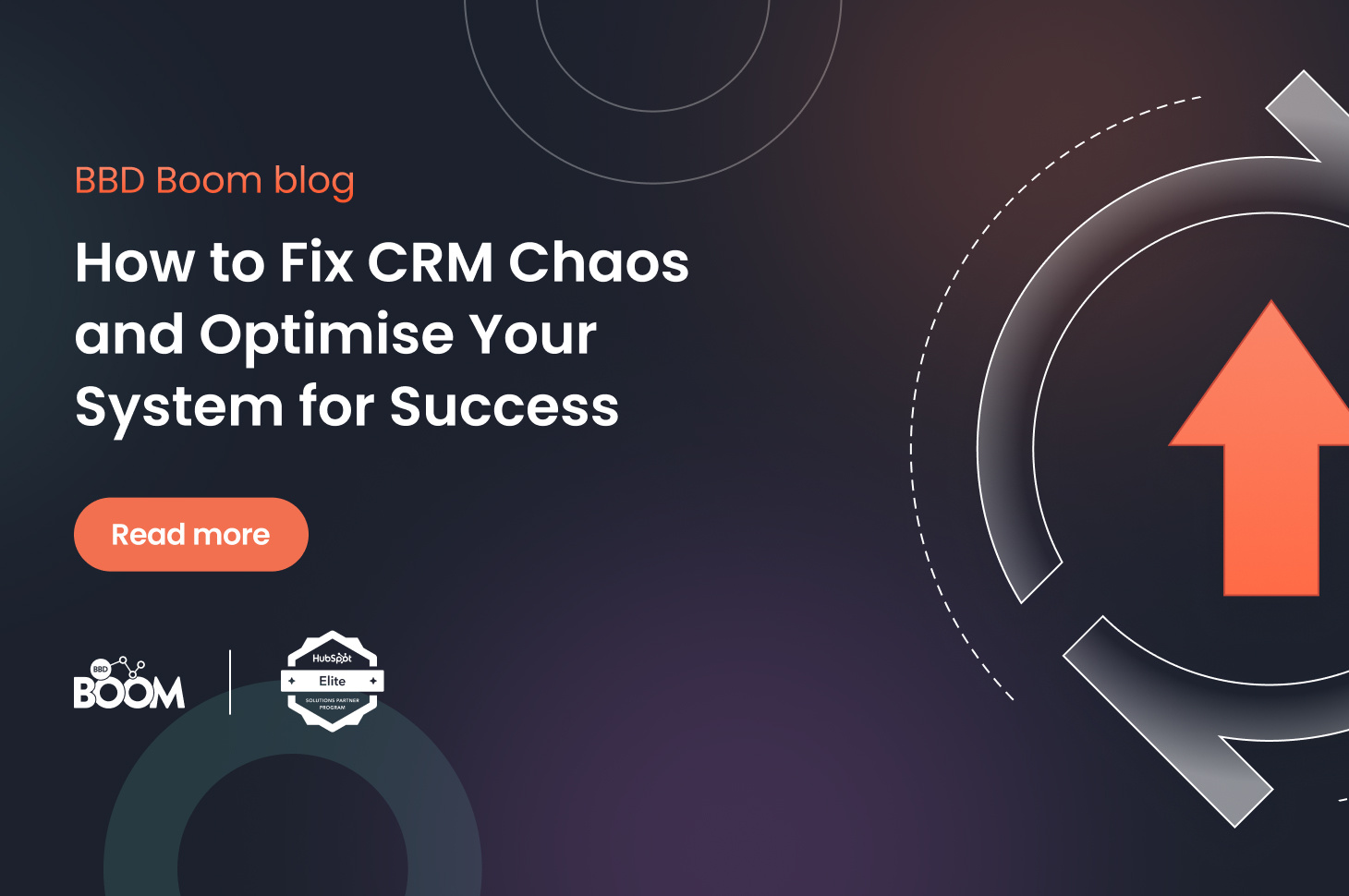Have you found yourself managing a CRM that’s cluttered, disorganised, and holding your business back? Whether it’s outdated data, broken automations, or a system no one really trusts, we’ve seen it ALL! CRM chaos is a common challenge for modern businesses, but with the right strategy, you can clean it up, optimise it, and make it work for you. Let's find out how.
Common Signs of CRM Chaos
CRM chaos isn’t caused by bad intentions. It happens gradually and often invisibly. Maybe the system was set up by someone who’s no longer with the business. Maybe different teams added their own tweaks without much collaboration. Maybe it just evolved organically as your business grew, until one day you realised it was no longer working for you - it was working against you.

Knowing when your CRM needs a clean up can be tricky, here are some of the common signs of CRM chaos:
Duplicated and Outdated Data
Duplicated and outdated data are red flags that your CRM isn't up to scratch. When the same contact shows up multiple times or hasn't been updated with key information, it can lead to confusion and ultimately bad decisions. Sales teams might follow up on the same lead twice, or even chase someone who’s no longer at the company. Not only this but reporting gets skewed and no-one will trust the system. If people can’t rely on the data, they’ll stop using the CRM altogether - and that’s when the real chaos kicks in.
Over-engineered Setup
An over-engineered CRM setup is another classic sign of potential chaos. When there are too many custom fields, complex automations or integrations no one understands, it just slows everyone down. Instead of helping the team, the system becomes something they have to fight with.
Key Staff Member Leaving
When a key staff member leaves and takes all the CRM know-how with them, that’s a clear sign of trouble. If the system relies heavily on one person to run smoothly, it means there’s no shared understanding. Suddenly, no one knows how to things work. It creates a bottleneck and exposes how fragile the setup really is.
Outdated or Underutilised Tools
Outdated or underutilised tools usually means your CRM setup hasn’t kept up with the way your team actually works. Maybe the business has changed, but the tools didn’t. Or maybe people never got proper training and just stopped using them. Either way, you end up with a system full of features no one touches and subscriptions that are draining your budget.
No Clear Governance
Your system can get messy when there's no clear governance. When there’s no one owning the system, setting rules or keeping things tidy, everyone just does their own thing. Processes eventually become inconsistent and no one’s really sure what “right” looks like anymore, so without guidelines your CRM turns into a free-for-all, and it very quickly becomes less and less useful to everyone.
Inaccurate Reporting
Inaccurate reporting is a major sign your CRM needs help! If the data going into your system is messy, incomplete or inconsistent - the reports coming out just cannot be trusted. This means bad forecasting and a whole lot of second guessing. If your teams don't trust the data coming out, they'll simply move to spreadsheets and go back to manual processes - which defeats the entire point of a CRM.
If any one of these points resonate with your system, you're not alone in this. The reality is many businesses inherit some form of CRM chaos overtime.
Regain Control of Your CRM with Quick Fixes
Step 1: HubSpot Audit & Data Health Check
Running a data audit is the first step to regaining control, it can help you see exactly where your problems are so you know where to start. If you're using HubSpot the Data Quality Management Centre will give you a clear overview of your data health, highlighting any issues across your companies, contacts etc. The Duplicate Management tool helps you find and merge repeated data. And with a Properties Audit you can clean up and confusing or unused fields that clutter your system.
Step 2: Cleaning Your Data & Fixing Processes
Your data and processes are what keeps your CRM running smoothly, keeping these in top condition is essential for maximising your systems efficiency. To clean your data it is important to remove any duplicated or outdated records to minimise clutter, delete or archive inactive contacts - especially those that bounce or have left companies and consolidate custom properties by reviewing what's actually used and removing those that aren't.
To fix processes it's a good idea to map out your key processes using User Journey Mapping to spot any bottlenecks or gaps in automation. Reviewing your existing automations is also important to ensure they are still relevant and working in line with your current customer journey. On top of these you need to ensure your team has clear rules for data entry so that once your CRM is cleaned up, this standard will remain consistent.
Step 3: Implement Quick Fixes and Optimisations
It's easy to see your CRM and get overwhelmed, but you don't have to do everything in one go. Start by implementing a few quick fixes and slowly everything will begin to fall into place.
Fixing any lead routing issues will immediately get rid of constantly missed opportunities - this means your leads will always be assigned to the correct person. Moreover, cleaning up your key dashboards will ensure your team has clear, useful insights that they can actually act on. Tidying up workflows is also a great quick win, by removing any broken steps or creating simpler triggers, you can make sure that automation works for you, not against you.
And once the small fires are out, it's time to think bigger. If you build a CRM roadmap, you can lay out exactly what needs to be fixed, improved or rebuilt overtime - this should be based on your teams needs and your business goals. To ensure adoption to these changes stay strong, target high impact changes first and ensure you involve your team from the get go.
Optimising for Long-Term Success
Step 4: Documentation and Governance
A well run CRM needs clear ownership and solid rules. Without them, things will start to slip through the cracks. That's why you need to assign CRM ownership, by designating a CRM owner or admin, this means they are responsible for maintaining the system, managing the updates and also supporting users. Also making sure everyone has clear roles will help keep the system stay in consistently top form. If you implement governance best practices like reviewing user permissions or documenting your processes this will also keep things running smoothly.
Step 5: Leverage Automation and AI
Let HubSpot's AI and automation features do the heavy lifting for you! When you have these tools it would be foolish not to use them to your advantage. Utilise Breeze Intelligence Data Enrichment tool to automatically fill in any missing contact or company information (like industry, size, job titles) to make sure your records are complete and actually useful to you. Your team can use automated workflows to handle any repetitive tasks like lead assignment, lifecycle stage updates or follow up reminders. This minimises manual input and therefore reduces the risk of mistakes!
Have a read of our blog 'Unlock the Power of HubSpot's Breeze Intelligence' to further your understanding of HubSpot's AI capabilities.
Step 6: Driving User Adoption and Team Training
So you have your CRM fixed up, what's next? Even the best CRM won’t deliver results if people don’t know how to use it properly. Training and adoption are key. You need to make sure your marketing, sales and service teams are using HubSpot consistently, from lead capture all the way through to customer support. This means they will familiarise themselves with it and won't reject the new ways. Additionally documenting the whole journey will keep processes aligned across teams, avoiding any gaps or confusion.
It is also recommended to offer role specific training for your teams, this means sales won't need to sit through talks about marketing workflows and vice versa. By training up your employees they will feel more confident in the system they work with, meaning adoption rates will be higher. Use a mix of live sessions, video tutorials and HubSpot Academy training videos for offering training to your team, or alternatively work with a HubSpot partner like us at BBD Boom. Our training will offer your team the support they need to boost confidence.
You Don’t Have to DIY!
As a HubSpot partner, we’ve been in the trenches with companies that felt completely stuck. But with the right approach and the right support you can turn things around. The results? Better data. Better team alignment. And a CRM that actually helps you grow. At BBD Boom, we specialise in transforming messy HubSpot setups into powerful, scalable systems. Whether you need a full rebuild, a tidy-up, or just someone to talk it through with, we’re here to help.
👋 Want to start with a no-pressure CRM Health Check?
If you suspect there’s room for improvement in your HubSpot platform, our FREE audit will pinpoint opportunities to optimise your setup, streamline your processes, and ensure you’re getting the most out of HubSpot. Let’s make your platform work harder for your business - book your FREE audit today!
.png?width=877&height=508&name=bbd-boom-siloy-navy+blue-logo%20(1).png)
.png)

.jpg)

-1.png?width=50&name=Webinar%20Speakers%20(1)-1.png)

.png?width=1000&height=300&name=Download%20FREE%20Data%20Cleansing%20Checklist%20(1).png)
.png?width=2000&height=600&name=BBD-Boom%20(2).png)

-1.png?width=90&name=Webinar%20Speakers%20(1)-1.png)


